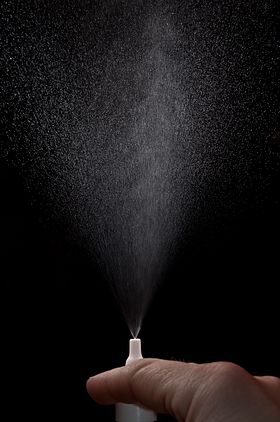| This article needs more reliable medical references for verification or relies too heavily on primary sources. Please review the contents of the article and add the appropriate references if you can. Unsourced or poorly sourced material may be challenged and removed. Find sources: "Nasal spray" – news · newspapers · books · scholar · JSTOR (November 2017) |  |
Medical intervention
| Nasal spray | |
|---|---|
 Actuation of a nasal spray bottle, used to deliver medication via the nostrils Actuation of a nasal spray bottle, used to deliver medication via the nostrils | |
| Other names | nasal drops |
| [edit on Wikidata] | |
Nasal sprays are used to deliver medications locally in the nasal cavities or systemically. They are used locally for conditions such as nasal congestion and allergic rhinitis. In some situations, the nasal delivery route is preferred for systemic therapy because it provides an agreeable alternative to injection or pills. Substances can be assimilated extremely quickly and directly through the nose. Many pharmaceutical drugs exist as nasal sprays for systemic administration (e.g. sedative-analgesics, treatments for migraine, osteoporosis and nausea). Other applications include hormone replacement therapy, treatment of Alzheimer's disease and Parkinson's disease. Nasal sprays are seen as a more efficient way of transporting drugs with potential use in crossing the blood–brain barrier.

Antihistamines
Antihistamines work by competing for receptor sites to block the function of histamine, thereby reducing the inflammatory effect. Antihistamine nasal sprays include:
- Azelastine hydrochloride
- Levocabastine hydrochloride
- Olopatadine hydrochloride
Corticosteroids
Corticosteroid nasal sprays can be used to relieve the symptoms of sinusitis, hay fever, allergic rhinitis and non-allergic (perennial) rhinitis. They can reduce inflammation and histamine production in the nasal passages, and have been shown to relieve nasal congestion, runny nose, itchy nose and sneezing. Side effects may include headaches, nausea and nose bleeds. Corticosteroid nasal sprays include:
- Beclomethasone dipropionate
- Budesonide
- Ciclesonide
- Flunisolide
- Fluticasone furoate
- Fluticasone propionate
- Mometasone
- Triamcinolone acetonide
Saline
Saline sprays are typically non medicated. A mist of saline solution containing sodium chloride is delivered to help moisturize dry or irritated nostrils. This is a form of nasal irrigation. They can also relieve nasal congestion and remove airborne irritants such as pollen and dust thereby providing sinus allergy relief.
Three types of nasal sprays preparations of sodium chloride are available including hypertonic (3% sodium chloride or sea water), isotonic (0.9% sodium chloride) and hypotonic (0.65% sodium chloride). Isotonic solutions have the same salt concentration as the human body, whereas hypertonic solutions have a higher salt content and hypotonic solutions have a lower salt content. Isotonic saline nasal sprays are commonly used in infants and children to wash out the thick mucus from the nose in case of allergic rhinitis. Hypertonic solutions may be more useful at drawing moisture from the mucous membrane and relieving nasal congestion.
Natural nasal sprays that include chemical complexes derived from plant sources such as ginger, capsaicin and tea-tree oil are also available. There is however no trial-verified evidence that they have a measurable effect on symptoms.
Topical decongestants
Decongestant nasal sprays are available over-the-counter in many countries. They work to very quickly open up nasal passages by constricting blood vessels in the lining of the nose. Prolonged use of these types of sprays can damage the delicate mucous membranes in the nose. This causes increased inflammation, an effect known as rhinitis medicamentosa or the rebound effect. Decongestant nasal sprays are advised for short-term use only, preferably 5 to 7 days at maximum. Some doctors advise to use them 3 days at maximum. A recent clinical trial has shown that a corticosteroid nasal spray may be useful in reversing this condition. Topical nasal decongestants include:
Allergy combinations
Combination use of two medications as nasal spray preparation has been frequently prescribed by doctors.
List of some combination nasal sprays:
- Azelastine together with fluticasone propionate (brand names including Dymista)
- Xylometazoline together with cromoglicic acid
In some countries, Dymista is marketed by Viatris after Upjohn merged with Mylan to create Viatris.
In 2022, the combination azelastine/fluticasone was the 299th most commonly prescribed medication in the United States, with more than 300,000 prescriptions.
References
- "Breakthrough: Nasal Spray May Soon Replace Pills for Delivering Drugs to the Brain". Science Daily. Science Daily. 21 May 2014. Retrieved 30 March 2015.
- Rizzo MC, Solé D, Naspitz CK (2007). "Corticosteroids (inhaled and/or intranasal) in the treatment of respiratory allergy in children: safety vs. efficacy". Allergologia et Immunopathologia. 35 (5): 197–208. doi:10.1157/13110315. PMID 17923074. S2CID 13622570.
- Vaidyanathan S, Williamson P, Clearie K, Kahn F, Lipworth B (July 2010). "Fluticasone reverses oxymetazoline-induced tachyphylaxis of response and rebound congestion". American Journal of Respiratory and Critical Care Medicine. 182 (1): 19–24. doi:10.1164/rccm.200911-1701OC. PMID 20203244.
- "Dymista/Dylastine (Viatris Pty Ltd)". Therapeutic Goods Administration (TGA). 1 July 2024. Retrieved 8 July 2024.
- "Pfizer Completes Transaction to Combine Its Upjohn Business with Mylan". Pfizer. 16 November 2020. Retrieved 17 June 2024 – via Business Wire.
- "Brands". Viatris. 16 November 2020. Retrieved 17 June 2024.
- "The Top 300 of 2022". ClinCalc. Archived from the original on 30 August 2024. Retrieved 30 August 2024.
- "Azelastine; Fluticasone Drug Usage Statistics, United States, 2013 - 2022". ClinCalc. Retrieved 30 August 2024.
External links
 Media related to Nasal sprays at Wikimedia Commons
Media related to Nasal sprays at Wikimedia Commons





